The Night Sky December 2014
Compiled by Ian Morison
This page, updated monthly, will let you know some of the things that you can look out for in the night sky. It lists the phases of the Moon, where you will see the naked-eye planets and describes some of the prominent constellations in the night sky during the month.
Cambridge University Press has recently published two books by the author.
An Amateurs Guide to Observing and Imaging the Heavens is a handbook to bridge the gap between the beginner's books on amateur astronomy and the books which cover a single topic in great detail. Stephen James O'Meara and Damian Peach have both given it excellent reviews.
'A Journey through the Universe' covering our current understanding of the Universe (up to June this year) was published on the 25th of September. Martin Rees has written a very nice review of it.
Image of the Month
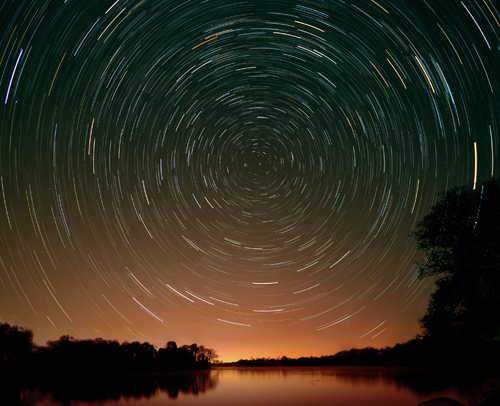
Star trails above Reedsmere in Cheshire
Image: Ian Morison
This pleasant, but not outstanding, image of star trails above Reedsmere in Cheshire is included to highlight a superb piece of free software. In the past, the taking of a star trails image was quite easy: for the classic shot, one simply pointed a film camera at the North Celestiall Pole and took a single long exposure. The problem with DSLR's is that due to 'dark current' produced in the sensor, long exposures become very noisy. The modern technique is thus to to take many short (~30 second) exposures which must then be combined to produce the star trails image. A program called
StarStaX , written by Markus Enzweiler, can be downloaded by searching for 'StarStaX softpedia'. This program will accept and stack the set of images and even fill in any small gaps between exposures. Brilliant. It allowed this image to be made up from 100, 30 second exposures of the polar region as seen from a lake in Cheshire. (Nikon D7000 DSLR with 10 mm lens at ISO 800.) As the view overlooked Manchester to the north, the sky was very red due to light pollution and this was reduced in Photoshop simply by adjusting the 'red level' within the levels command. You can spot the dotted trails of aircraft above Manchester in the full sized image.
Highlights of the Month
December - the first good month to view Jupiter.
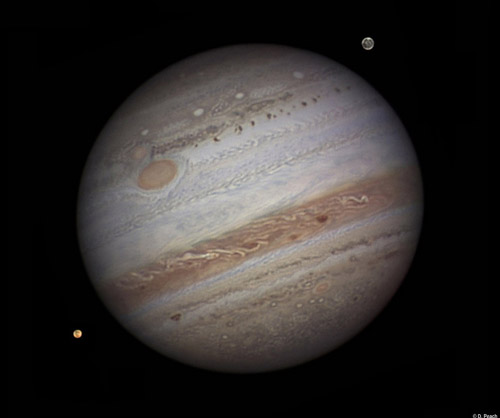
Jupiter imaged by Damian Peach
This is the first of several great months to observe Jupiter. It now lies in Leo and so is still high in the ecliptic and hence, when due south, at an elevation of ~55 degrees. It is looking somewhat different than in the last few years as the north equatorial belt has become quite broad. The Great Red Spot is currently a pale shade of pink but can be easily seen as a large feature (though possibly shrinking slightly in size) in the South Equatorial Belt.
The features seen in the Jovian atmosphere have been changing quite significantly over the last few years - for a while the South Equatorial Belt vanished completely (as seen in Damian's image) but has now returned to its normal wide state. The diagram on right shows the main Jovian features as imaged by the author at the beginning of December 2012.
The image by Damian Peach was taken with a 14 inch telescope in Barbados where the seeing can be particularly good. This image won the "Astronomy Photographer of the Year" competition in 2011.
See more of Damian Peach's images: Damian Peaches Website"
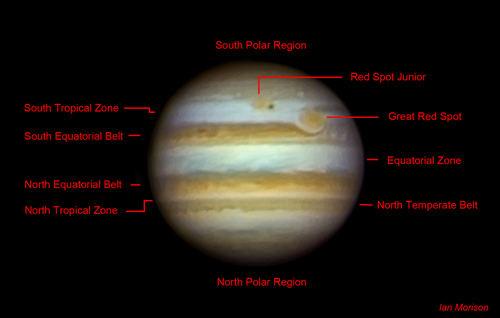
Features in Jupiter's atmosphere - December 2013.
December 3rd and 4th:
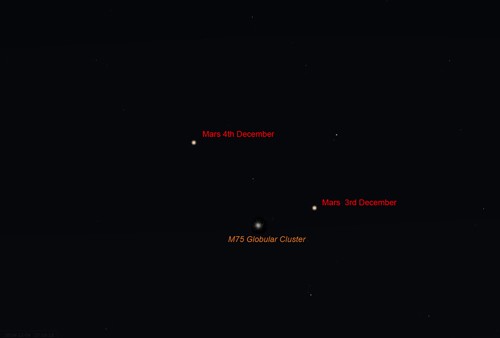
Mars close to the globular cluster M75
Image: Stellarium/IM
On the evening of the 3rd, Mars is just 18 arc minutes to the right of the globular cluster M75 whilst on the 4th it lies just 38 minutes just above and to its left. You will need a low horizon in the southwest to observe it about an hour after sunset.
December 14th and 15th after midnight: the Geminid Meteor Shower.
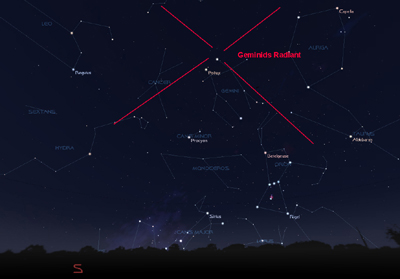
Image:Stellarium/IM
The Geminids
The early mornings of December 14th and 15th will give us the chance, if clear, of observing the peak of the Geminid meteor shower. Sadly, this is not too good a year as a third quarter Moon, in Leo on the 14th and Virgo on the 15th, will somewhat hinder our view This means that you will only see the brighter trails by looking high up away from the glare of the Moon. An observing location well away from towns or cities will also pay dividends though. The relatively slow moving meteors arise from debris released from the asteroid 3200 Phaethon. This is unusual, as most meteor showers come from comets . The radiant - where the meteors appear to come from - is close to the bright star Castor in the constellation Gemini as shown on the chart. If it is clear it will be cold - so wrap up well, wear a woolly hat and have some hot drinks with you.
December 19th and 20th - 1 hour before dawn: Saturn and a crescent Moon
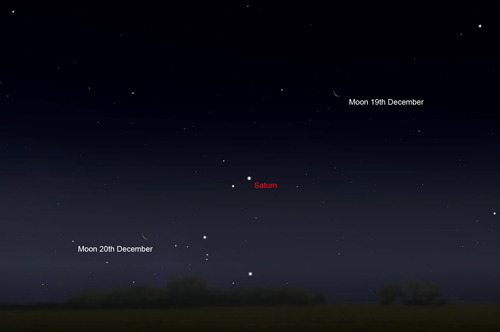
Saturn and a crescent Moon.
Image: Stellarium/IM
Before dawn on the 19th and 20th of December, Saturn will be seen close to a waning crescent Moon as shown on the chart.
December 22nd and 23rd - 30 minutes after sunset: Venus and a thin waxing crescent Moon
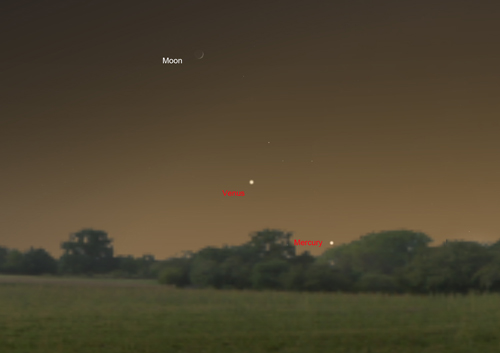
Venus and a waxing crescent Moon.
Image: Stellarium/IM
After sunset on the 22nd and 23rd of December, Venus will, if clear and given a low south-western horizon, be seen close to a very thin waxing crescent Moon as shown on the chart. You might also be able to spot Mercury close to the horizon.
December 22nd/23rd - midnight onwards : the Ursid Meteor Shower
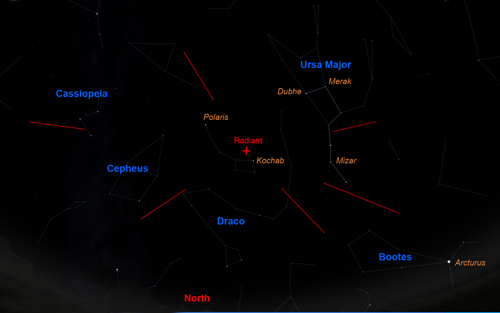
The Ursid meteor shower
The night of the 22nd/23rd December is when the Ursid meteor shower is at its best - though the peak rate of ~10-15 meteors per hour is not that great. The Moon is new. so moonlight will not obstruct our view in the hours before dawn. The radiant lies close to the star Kochab in Ursa Minor (hence their name), so look northwards at a high elevation. Occasionally, there can be a far higher rate so its worth having a look should it be clear.
December 24th and 25th - 1 hour after sunset: Mars and a waxing crescent Moon
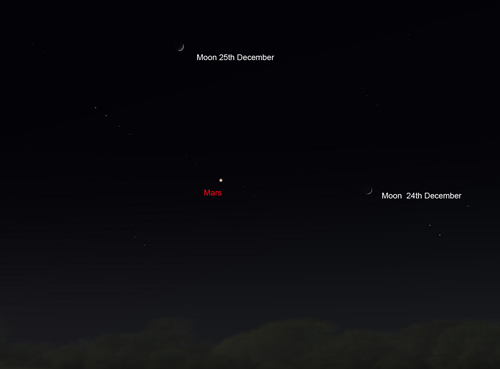
Mars and a waxing crescent Moon.
Image: Stellarium/IM
After sunset on the 24th and 25th of December,Mars will be seen close to a waxing crescent Moon as shown on the chart.
December - 13th and 29th: The Alpine Valley
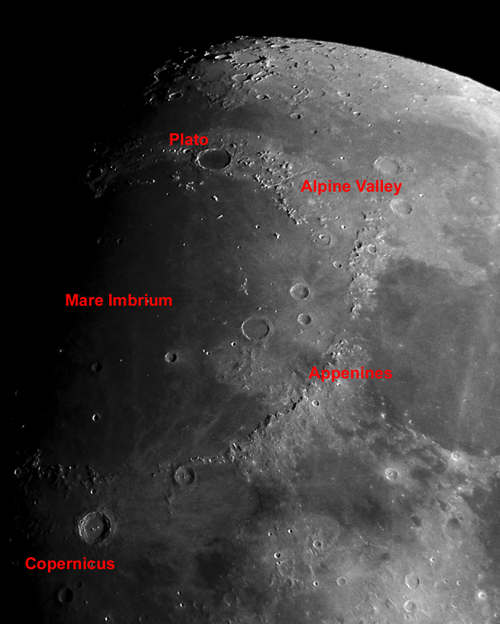
Alpine Valley region
An interesting valley on the Moon: The Alpine Valley
These are good nights to observe an interesting feature on the Moon if you have a small telescope. Close to the limb is the Appenine mountain chain that marks the edge of Mare Imbrium. Towards the upper end you should see the cleft across them called the Alpine valley. It is about 7 miles wide and 79 miles long. As shown in the image a thin rill runs along its length which is quite a challenge to observe. Over the next two nights following the 3rd/4th the dark crater Plato and the young crater Copernicus will come into view. This is a very interesting region of the Moon!

The Alpine valley and the crater Plato
M 109 imaged with the Faulkes Telescope

Messier galaxy M 109
Image: Danial Duggan
Faulkes Telescope North.
Spiral galaxy M109, imaged by Daniel Duggan.
This image was taken using the Faulkes Telescope North by Daniel Duggan - for some time a member of the Faulkes telescope team. M 109 is a Barred Spiral some 83 million light years away that lies is a loose collection of Galaxies called the Ursa Major Cloud that may contain over 50 galaxies.
Learn more about the Faulkes Telescopes and how schools can use them: Faulkes Telescope"
Observe the International Space Station

The International Space Station and Jules Verne passing behind the Lovell Telescope on April 1st 2008.
Image by Andrew Greenwood
Use the link below to find when the space station will be visible in the next few days. In general, the space station can be seen either in the hour or so before dawn or the hour or so after sunset - this is because it is dark and yet the Sun is not too far below the horizon so that it can light up the space station. As the orbit only just gets up the the latitude of the UK it will usually be seen to the south, and is only visible for a minute or so at each sighting. Note that as it is in low-earth orbit the sighting details vary quite considerably across the UK. The NASA website linked to below gives details for several cities in the UK. (Across the world too for foreign visitors to this web page.)
Note: I observed the ISS three times recently and was amazed as to how bright it has become.
Find details of sighting possibilities from your location from: Location Index
See where the space station is now: Current Position
The Moon
 The Moon at 3rd Quarter. Image, by Ian Morison, taken with a 150mm Maksutov-Newtonian and Canon G7.
The Moon at 3rd Quarter. Image, by Ian Morison, taken with a 150mm Maksutov-Newtonian and Canon G7.
Just below the crator Plato seen near the top of the image is the mountain "Mons Piton". It casts a long shadow across the maria from which one can calculate its height - about 6800ft or 2250m.
| new moon |
first quarter |
full moon |
last quarter |
`
| December 22nd |
December 28th |
December 6th |
December 14th |
Some Lunar Images by Ian Morison, Jodrell Bank Observatory: Lunar Images
A World Record Lunar Image
 The 9 day old Moon.
The 9 day old Moon.
To mark International Year of Astronomy, a team of British astronomers have made the largest lunar image in history and gained a place in the Guinness Book of Records! The whole image comprises 87.4 megapixels with a Moon diameter of 9550 pixels. This allows details as small as 1km across to be discerned! The superb quality of the image is shown by the detail below of Plato and the Alpine Valley. Craterlets are seen on the floor of Plato and the rille along the centre of the Alpine valley is clearly visible. The image quality is staggering! The team of Damian Peach, Pete lawrence, Dave Tyler, Bruce Kingsley, Nick Smith, Nick Howes, Trevor Little, David Mason, Mark and Lee Irvine with technical support from Ninian Boyle captured the video sequences from which 288 individual mozaic panes were produced. These were then stitched together to form the lunar image.
 Plato and the Alpine Valley.
Plato and the Alpine Valley.
Please follow the link to the Lunar World Record website and it would be really great if you could donate to Sir Patrick Moore's chosen charity to either download a full resolution image or purchase a print.
The Planets

A montage of the Solar System. JPL / Nasa
Jupiter

A Cassini image of Jupiter . Nasa
Jupiter shining at magnitude -2.2, rises at around 22:00 UT at the beginning of the month lying around 10 degrees up to the right of Regulus in Leo. The speed of its motion eastwards across the sky has slowed down as, on the 10th, it will begin its retrograde motion westwards across the heavens. On the 9th of the month, it is at its closest to Regulus in Leo, lying about 7 degrees to its upper right. By the end of the month it rises well over an hour earlier at ~20:00 UT with a slight increase in magnitude to -2.4. It will then be due south and so highest in the sky at an elevation of 53 degrees at around 05:30 UT in the early hours of the morning. As the Earth moves towards Jupiter, the size of Jupiter's disk increases slightly from 40 to 43 arc seconds so early risers should be easily able to see the equatorial bands in the atmosphere and the four Gallilean moons as they weave their way around it.
See highlight above.
Saturn

The planet Saturn. Cassini - Nasa
Saturn. having passed behing the Sun on the 18th of November is now a morning object, rising an hour before sunrise as the month begin but three hours before at its end. It is lying in Libra moving eastwards above Antares and the stars that mark the head of Scorpius. It will be shining at magnitude +0.5 and be high enough in the south-east before dawn to make out the beautiful ring system which has now opened out to ~24 degrees.
See highlight above.
Mercury

Messenger image of Mercury Nasa
Mercury passes in front of the Sun on December the 8th, so will not be visible until its very end when it might just be glimpsed low in the south-west after Sunset. It will be seen (probably needing binoculars) down to the lower right of Venus - on New Year's Eve its magnitude will be -0.8 and be 3.5 degrees away from Venus so they will be seen in the field of a pair of low power binoculars.
Mars

A Hubble Space Telescope image of Mars.
Jim Bell et al. AURA / STScI / Nasa
Mars is moving eastwards relative to the stars and crosses from Sagittarius into Capricornus on the 4th. On the evening of the 3rd it will lie less than 1/3 of a degree from the globular cluster M75. It dims slightly from magnitude +1 to +1.1 during the month as the angular size of its disk falls from 5.1 down to 4.8 arc seconds. It is best observed as darkness falls, low above the south western horizon (so will need to be observed with a low horizon in this direction). Given its low elevation, no details will be seen on its salmon-pink suface. Due to its eastwards movement it sets about three hours after the Sun all month.
See highlights above.
Venus

Venus showing some cloud structure
Venus, having passed behid the Sun in October is now an evening object setting some 45 miutes after Sun as the month begins increasing to to 75 minutes at its end. So towards the New Year,shining at magnitude -3.9 it should be easy to spot low above the southwestern horizon. Its angular size is about 10 arc seconds and will appear as a small dot, blurred by atmospheric turbulance. I suspect that, due to its low elevation, its light will be split into a short vertical spectrum by refraction in the atmosphere.
See highlight above.

Radar image showing surface features
Find more planetary images and details about the Solar System: The Solar System
The Stars
The Late Evening December Sky
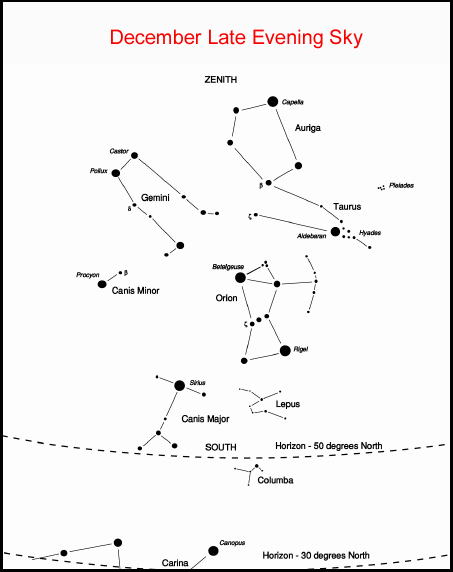 The December Sky in the south - late evening
The December Sky in the south - late evening
This maps shows the constellations seen towards the south in early and late evening. Setting towards the west in early evening is the beautiful region of the Milky Way containing both Cygnus and Lyra. Below is Aquilla. The three bright stars Deneb (in Cygnus), Vega (in Lyra) and Altair (in Aquila) make up the "Summer Triangle". East of Cygnus is the great square of Pegasus - adjacent to Andromeda in which lies M31, the Andromeda Nebula. To the north lies "w" shaped Cassiopeia and Perseus. The lower map shoesthe constellation Taurus, with its two lovely clusters, the Hyades and the Pleaides, and is also described in more detail below. as the evening draws on, Orion, the Hunter, follows Taurus into the eastern sky with the constellations Auriga, above, and Gemini, to the upper left. Later Sirius, in Canis Major will be seen to the lower left of Orion. Due to its brightness and scintillations caused by the atmosphere it often appears as a rainbow of colours flashing in the sky.
The constellations Pegasus and Andromeda
 Pegasus and Andromeda
Pegasus and Andromeda
Pegasus
The Square of Pegasus is in the south during the evening and forms the body of the winged horse. The square is marked by 4 stars of 2nd and 3rd magnitude, with the top left hand one actually forming part of the constellation Andromeda. The sides of the square are almost 15 degrees across, about the width of a clentched fist, but it contains few stars visibe to the naked eye. If you can see 5 then you know that the sky is both dark and transparent! Three stars drop down to the right of the bottom right hand corner of the square marked by Alpha Pegasi, Markab. A brighter star Epsilon Pegasi is then a little up to the right, at 2nd magnitude the brightest star in this part of the sky. A little further up and to the right is the Globular Cluster M15. It is just too faint to be seen with the naked eye, but binoculars show it clearly as a fuzzy patch of light just to the right of a 6th magnitude star.
Andromeda
The stars of Andromeda arc up and to the left of the top left star of the square, Sirra or Alpha Andromedae. The most dramatic object in this constellation is M31, the Andromeda Nebula. It is a great spiral galaxy, similar to, but somewhat larger than, our galaxy and lies about 2.5 million light years from us. It can be seen with the naked eye as a faint elliptical glow as long as the sky is reasonably clear and dark. Move up and to the left two stars from Sirra, these are Pi amd Mu Andromedae. Then move your view through a rightangle to the right of Mu by about one field of view of a pair of binoculars and you should be able to see it easily. M31 contains about twice as many stars as our own galaxy, the Milky Way, and together they are the two largest members of our own Local Group of about 3 dozen galaxies.
 M31 - The Andromeda Nebula
M31 - The Andromeda Nebula
M33 in Triangulum
If, using something like 8 by 40 binoculars, you have seen M31 as described above, it might well be worth searching for M33 in Triangulum. Triangulum is
the small faint constellation just below Andromeda. Start on M31, drop down to Mu Andromedae and keep on going in the same direction by the same distance as you have moved from M31 to Mu Andromedae. Under excellent seeing conditions (ie., very dark and clear skies) you should be able to see what looks like a little piece of tissue paper stuck on the sky or a faint cloud. It appears to have uniform brightness and shows no structure. The shape is irregular in outline - by no means oval in shape and covers an area about twice the size of the Moon. It is said that it is just visible to the unaided eye, so it the most distant object in the Universe that the eye can see. The distance is now thought to be 3.0 Million light years - just greater than that of M31.
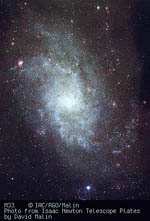 M33 in triangulum - David Malin
M33 in triangulum - David Malin
The constellation Taurus
 Taurus
Taurus
Taurus is one of the most beautiful constellations and you can almost imagine the Bull charging down to the left towards Orion. His face is delineated by the "V" shaped cluster of stars called the Hyades, his eye is the red giant star Aldebaran and the tips of his horns are shown by the stars beta and zeta Tauri. Although alpha Tauri, Aldebaran, appears to lie amongst the stars of the Hyades cluster it is, in fact, less than half their distance lying 68 light years away from us. It is around 40 times the diameter of our Sun and 100 times as bright.
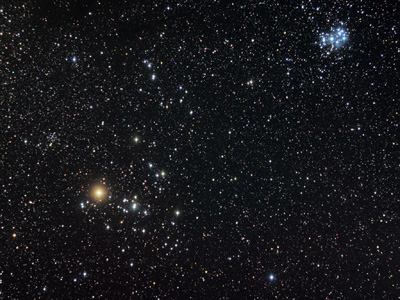 The Hyiades and Pleiades. Copyright: Alson Wong.
The Hyiades and Pleiades. Copyright: Alson Wong.
More beautiful images by Alson Wong : Astrophotography by Alson Wong
To the upper right of Taurus lies the open cluster, M45, the Pleiades. Often called the Seven Sisters, it is one of the brightest and closest open clusters. The Pleiades cluster lies at a distance of 400 light years and contains over 3000 stars. The cluster, which is about 13 light years across, is moving towards the star Betelgeuse in Orion. Surrounding the brightest stars are seen blue reflection nebulae caused by reflected light from many small carbon grains. These relfection nebulae look blue as the dust grains scatter blue light more efficiently than red. The grains form part of a molecular cloud through which the cluster is currently passing. (Or, to be more precise, did 400 years ago!)
 VLT image of the Crab Nebula
VLT image of the Crab Nebula
Close to the tip of the left hand horn lies the Crab Nebula, also called M1 as it is the first entry of Charles Messier's catalogue of nebulous objects. Lying 6500 light years from the Sun, it is the remains of a giant star that was seen to explode as a supernova in the year 1056. It may just be glimpsed with binoculars on a very clear dark night and a telescope will show it as a misty blur of light.
 Lord Rosse's drawing of M1
Lord Rosse's drawing of M1
Its name "The Crab Nebula" was given to it by the Third Earl of Rosse who observed it with the 72 inch reflector at Birr Castle in County Offaly in central Ireland. As shown in the drawing above, it appeared to him rather lile a spider crab. The 72 inch was the world's largest telelescope for many years. At the heart of the Crab Nebula is a neutron star, the result of the collapse of the original star's core. Although only around 20 km in diameter it weighs more than our Sun and is spinning 30 times a second. Its rotating magnetic field generate beams of light and radio waves which sweep across the sky. As a result, a radio telescope will pick up very regular pulses of radiation and the object is thus also known a Pulsar. Its pulses are monitored each day at Jodrell Bank with a 13m radio telescope.
The constellation Orion
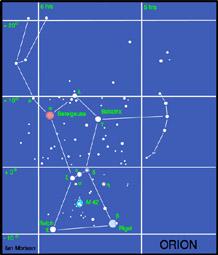 Orion
Orion
Orion, perhaps the most beautiful of constellations, will be seen in the south at around 11 - 12 pm during January. Orion is the hunter holding up a club and shield against the charge of Taurus, the Bull up and to his right. Alpha Orionis, or Betelgeuse, is a read supergiant star varying in size between three and four hundred times that of our Sun. The result is that its brightness varies somewhat. Beta Orionis, or Rigel, is a blue supergiant which, at around 1000 light years distance is about twice as far away as Betelgeuse. It has a 7th magnitude companion. The three stars of Orion's belt lie at a distance of around 1500 light years. Just below the lower left hand star lies a strip of nebulosity against which can be seen a pillar of dust in the shape of the chess-board knight. It is thus called the Horsehead Nebula. It shows up very well photographically but is exceedingly difficult to see visually - even with relativly large telescope.
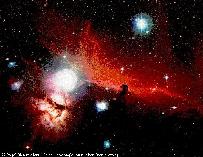 The Horsehead Nebula: Anglo Australian Observatory
The Horsehead Nebula: Anglo Australian Observatory
Beneath the central star of the belt lies Orion's sword containing one of the most beautiful sights in the heavens - The Orion Nebula. It is a region of star formation and the reddish colour seen in photographs comes from Hydrogen excited by ultraviolet emitted from the very hot young stars that make up the Trapesium which is at its heart. The nebula, cradling the trapesium stars, is a beautiful sight in binoculars or, better still, a telescope. To the eye it appears greenish, not red, as the eye is much more sensitive to the green light emitted by ionized oxygen than the reddish glow from the hydrogen atoms.
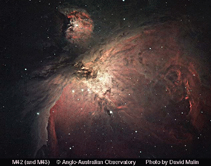 The Orion Nebula: David Malin
The Orion Nebula: David Malin





































